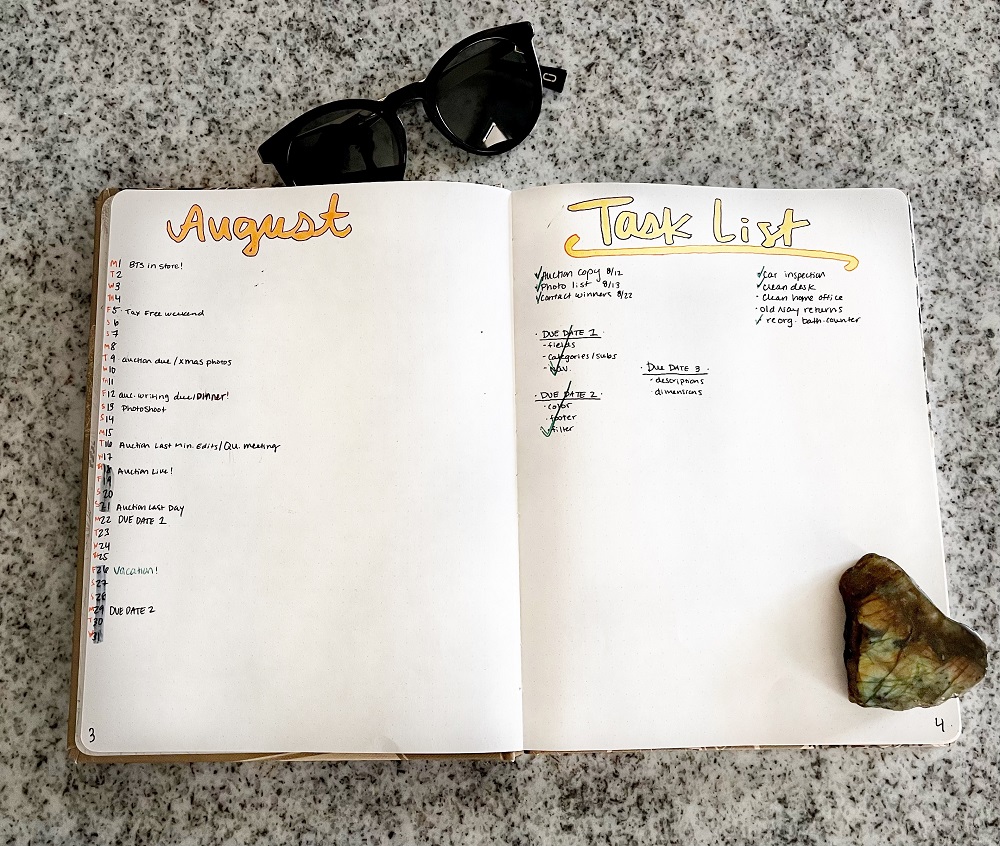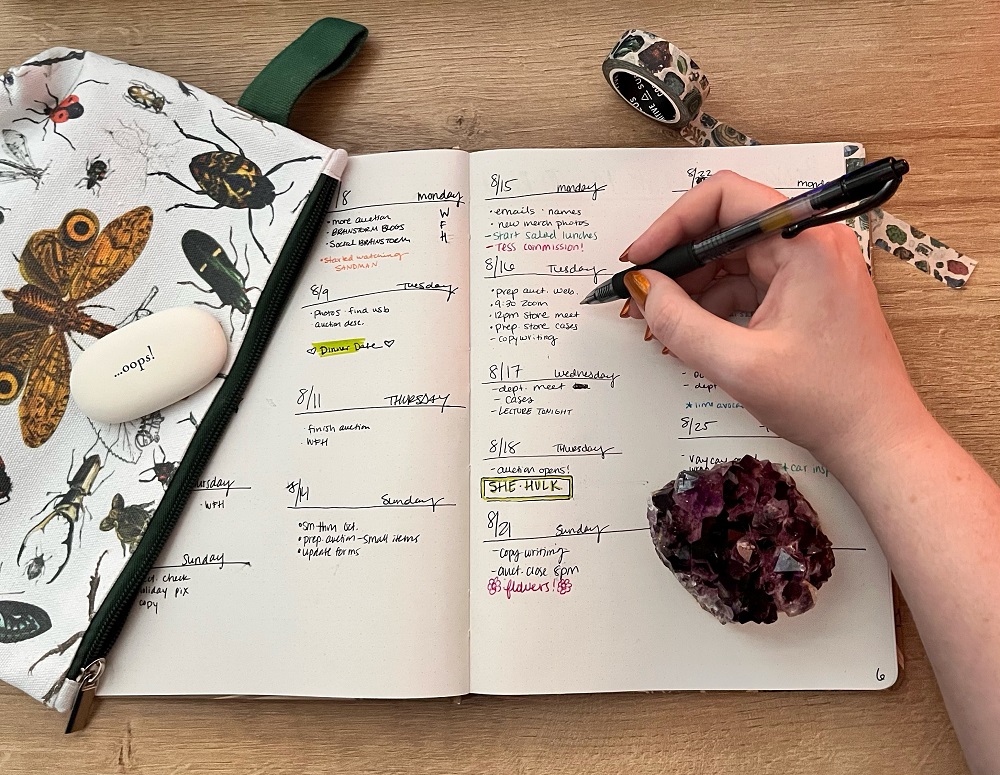New school year, new regular year, new job, new anything- I always want to make sure I’m starting off on the right foot by staying organized. I’d buy fancy planners and pens, new folders, multi-packs of different size sticky notes, anything that gives the appearance that I’m organized and prepared from here to Armageddon. But as time goes on, the organization system I’ve tried to mold myself into begins to fray at the edges as projects and stress begin building up. Before I know it, my organization system becomes my disorganized mess. My colorful planner layouts become less so as the months wear on and I stop engaging with it all together. Instead, I’m living life by the seat of my pants with haphazardly scrawled sticky notes stuck around like an out of control evidence board in police procedural shows.
So, where does that leave me? Dear reader, you and I both know that’s not a way to live. Which brings me to my current solution- the BuJo. It’s not a specialized product that you can get a boost of serotonin from the purchase, but a journaling technique to streamline your calendars, to-do lists, random thoughts, and personal diary- aka the Bullet Journal, or BuJo for short.

I was skeptical at first. How could a single journal save me (and my wallet) from my planning pitfalls? But, I was out of options. Besides, my collection of unmarked journals was only growing and this would give at least one of them purpose. My weapon of choice? The Archaeology Journal from the HMNS Museum Store, of course. There’s tons of excellent choices to be found in the store with covers ranging a variety of topics and colors, but my Anthropology degree in the corner told me there was only one choice and I listened. The pages are dot-grid rather than lined, which gives me a feeling of structured freedom that I desperately need lest my sentences start being scribbled askew. Straight-edges are for quitters (unless you use them, my friend).
I also snagged a few other snazzy items from the Museum Store for my Bullet Journal journey. It was so hard to choose from the wide selection of washi tape, but I went with the Gems & Minerals design because how can you not fill your journal with Gold and Malachite? I also grabbed the Insects Pencil Bag because I really did need something to carry my pens and tape in, and these pencil bags are HUGE. Seriously, I may grab another one just to keep my earbuds, keys, and chapstick from getting lost inside my purse. Finally, I thought outside the box a bit and got a gorgeous Amethyst chunk as a paperweight to hold the journal pages down as I write.
Despite what the BuJo hashtags on Instagram show you, the Bullet Journal method is incredibly simple. It’s composed of just five components; the Index, Future Log, Monthly Log, Monthly Task List, and the Daily Log.
The Index is the key ingredient, the backbone to making your Bullet Journal functional. Set aside a few pages at the beginning of your journal for your index, as you’ll take note of where everything in the journal lives here as the year progresses.

Kept near the front of your journal, the Future Log is where you’ll note upcoming events, due dates, projects, and anything that happens in the not now. Make sure to mark this page in your handy-dandy Index. See, it’s already working. Start your Monthly Log on the month you’re building your BuJo and add the page number to your Index. Write the days of the month down either side of the page for the Monthly Log, and add that month’s plans down on each date. Brevity is the soul of wit, and is an important factor for the Bullet Journal. If you have an appointment on the books for next month, add it to your Future Log list for now.
You can use the page opposite of the Monthly Log for your Monthly Task List to be able to take in your month at a glance. Mark it down in your Index. But you know what? This Task List is entirely skippable. Don’t have much going on in the month of March? Just skip it. What’s great with the Bullet Journal is that it reminds you that it’s your life, and if something doesn’t fit or have a place in it, let it go. Truly the Marie Kondo of journaling.

Finally, we get to the meat of the journal, your Daily Log. This is the catch-all of your tasks, random thoughts, things you did that day, and whatever else may have been significant about that day. Just like Captain James T. Kirk of the USS Enterprise, think of this section as your Star Trek-ian “Captain’s Log” where you jot down notes about the main parts of your day, some observations you’ve made, and reference in your Index. That way you can go back through your logs and solve the main plot line before the end of the episode. Or remember when 6 weeks ago you spilt coffee on all your paperwork right before the deadline. Totally not speaking from personal experience there. Promise.
So it’s the last day of the month and you’re wondering, “Hmm, guess I’ll start my next Monthly Log and keep on keepin’ on”. No. Wrong. Do not pass go, do not collect $200. Before you do anything else, you need to figure out Migration. What’s the point of writing the same to-do list every month? If you know you need to pay bills or walk the dog every day, you don’t have to migrate those tasks over to the new month. Same with chronically incomplete tasks. If you haven’t completed the task in three months, it gives you the chance to say, “What’s up” with it and figure out if it really is important.

And that’s it! 5+1 steps is all you need to start your Bullet Journal. If you want to take your journal a step further, consider Collections. These should ideally be lists you wouldn’t remember otherwise. Mine are books my friends recommend me, movies I want to watch but aren’t yet on any streaming services, and lists of products I want to try and if I like them after I do. These aren’t all together in any particular section of my journal- I make them as I go and add them to my index so I can find them again. I’ve also added little washi tape edges to these pages just in case I need to find them in a rush.
All in all, remember this: Using these journals aren’t supposed to give you stress by trying to use them, and when all else fails, remember the K.I.S.S. method- Keep It Simple, Silly. Don’t write down every little detail in your life if it makes your life harder, and do what’s intuitive for you. The journal is custom-made for you, and can evolve (or devolve) to fit your needs.
Before I sign off, some words of wisdom from the creator of the Bullet Journal method, Ryder Carroll.
“I like to describe the Bullet Journal Method as an empty house. I gave the community this house to fill it with their own lives. That’s the key, to furnish your space with the things that serve you. If the chair is too fancy, you won’t sit in it. If the kitchen is too complicated, you won’t cook in it… Be they minimal or artistic, make sure your pages remain true to you.”






